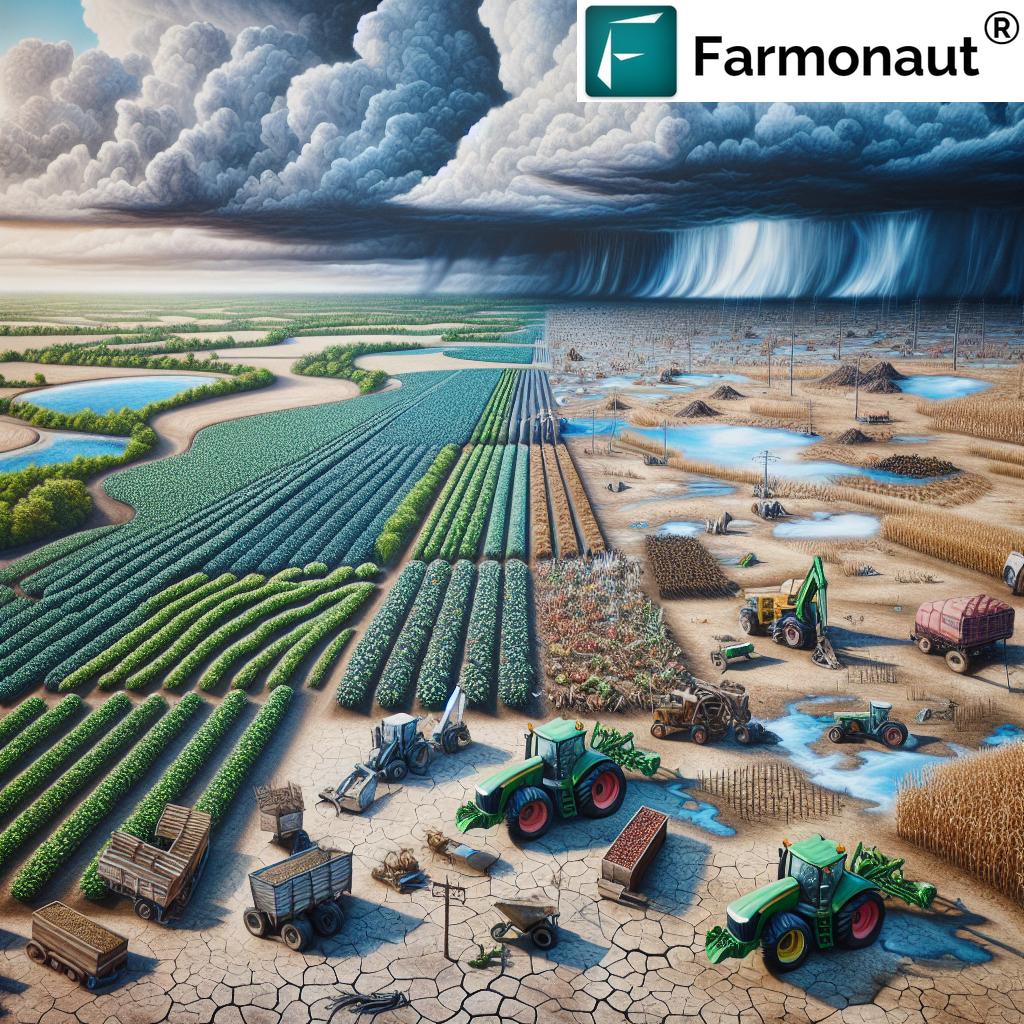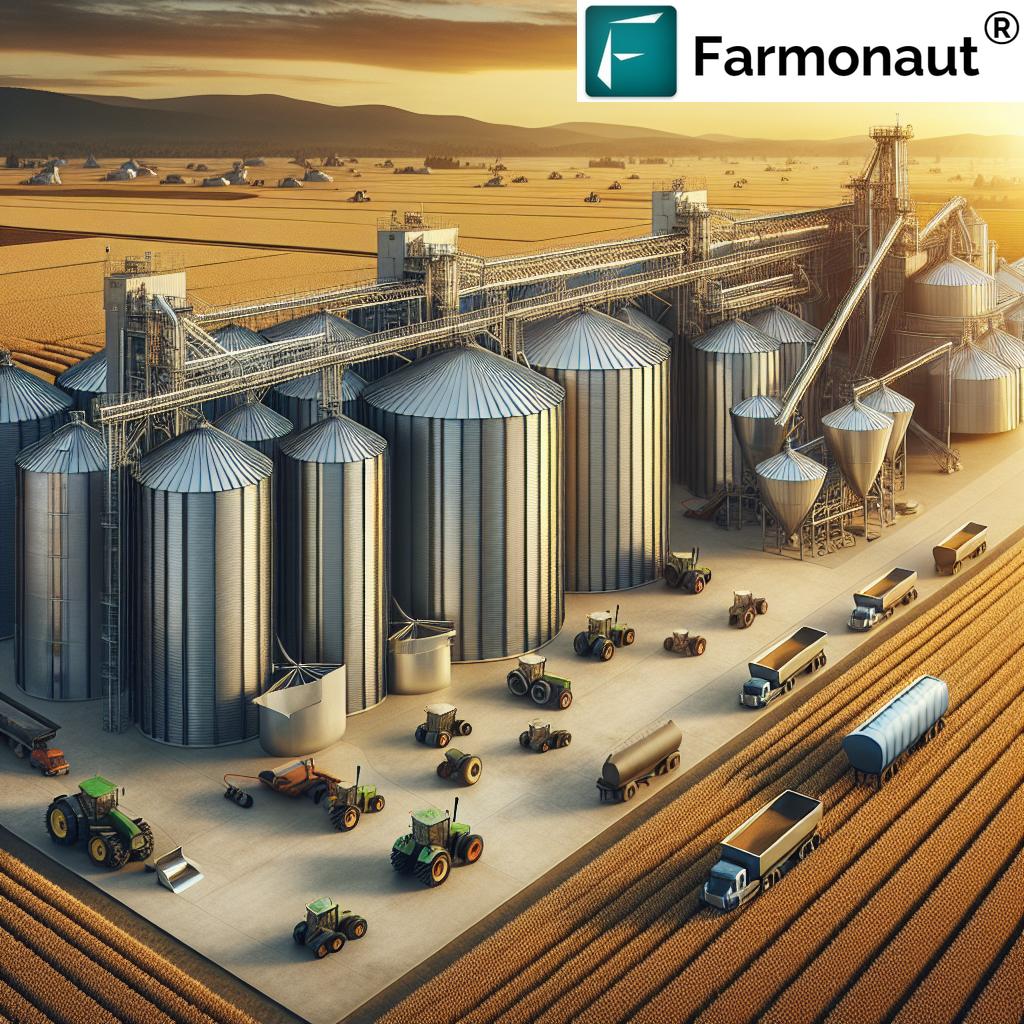Cow Fencing & Best Fencing for Sheep: Top Farm Supplies 2026
“Over 70% of farms upgraded to high-tensile steel or composite fencing for livestock security in 2025.”
- Importance of Fencing in Livestock Management
- Understanding Cow Fencing in 2026
- Best Fencing for Sheep: Modern Solutions for 2026
- Comparing Cow and Sheep Fencing Solutions 2025-2026
- Farm Fencing Supplies: What Farmers Need in 2026
- Rural Fencing Supplies: Tailored for Modern Farming
- Tractor Supply Field Fencing Innovations: Enhancing Efficiency
- Future Trends in Livestock Fencing: 2026 and Beyond
- How Farmonaut’s Satellite Technology Supports Farming
- FAQ: Cow Fencing, Best Fencing for Sheep, & Rural Fencing Supplies
- Conclusion: Modern Fencing for Productive Livestock Management
The evolution of cow fencing and best fencing for sheep has revolutionized livestock management, safeguarding the welfare of animals and the sustainability of modern agriculture. With the agricultural sector advancing rapidly, the landscape of livestock fencing has transformed with high-tech farm fencing supplies and smart monitoring solutions, responding to challenges and opportunities as we move into 2025 and beyond.
Effective fencing is no longer just a barrier—it’s a vital asset for every farm, ensuring the safety and productivity of livestock while facilitating efficient grazing management and enhanced resource utilization. This comprehensive article explores the latest in farm and rural fencing, delving into cow fencing solutions, best fencing for sheep, essential farm fencing supplies, rural fencing supplies, and unmatched innovations like tractor supply field fencing. With a close eye on 2026, we reveal smart practices, modern materials, and technology-driven trends every progressive farmer should know.
Importance of Fencing in Livestock Management
In the ever-evolving world of agriculture, fencing forms the backbone of effective livestock management. Its significance is far-reaching, not only by defining boundaries and protecting animals from predators but also by:
- Providing secure enclosures for cattle, sheep, and mixed livestock
- Controlling grazing patterns for optimal pasture usage
- Preventing escapes and livestock wandering into hazardous areas or neighboring properties
- Enhancing management through rotational grazing, breed segregation, and disease control
- Minimizing stress and accidental losses by establishing clear control over animals
Especially for sheep farming, where threats from coyotes, foxes, and wild dogs pose significant risk, choosing the right type of fencing is crucial. The correct system not only guards livestock but supports farm productivity and sustainability.
Understanding Cow Fencing in 2026
Cow fencing in 2026 is a blend of traditional wisdom and modern engineering, designed to address the size, strength, and behavior of cattle. Reliable cow fencing makes use of robust materials, proper height, and structural integrity to withstand pushing, leaning, and pressure from large animals.
Key Components of Effective Cow Fencing
- Material: High-tensile steel wire or composite materials resist weathering and animal force
- Height: At least 4 to 5 feet tall to prevent cows from jumping or leaning over
- Fence Type: Traditional woven, electric, or combination systems to deter escapes
- Sturdy Posts: Set at regular intervals with corner braces for tension
- Gates: Secure and wide enough for machinery and herd movement
Best Cow Fencing Options in 2026
- High-Tensile Wire Fencing: Offers flexibility, durability, and strength with minimal sag, ideal for pasture enclosures
- Electric Fencing: Delivers mild shocks to deter animals from pushing, combined with warning tape for enhanced visibility
- Woven Wire Fencing: Prevents calves from slipping through and withstands pressure from adult cattle; often reinforced with a hot wire strand at the top
When it comes to large-scale field installation, tractor supply field fencing tools like post drivers and mechanized wire stretchers have become standard, enhancing installation speed and consistency.
For comprehensive large scale farm management solutions, consider exploring Farmonaut’s Agro Admin App. This tool helps coordinate livestock tracking and integrates spatial data with fencing layouts to optimize operations.
“Smart monitoring fences reduced livestock escape incidents by 48% for sheep and cows by mid-2026.”
Best Fencing for Sheep: Modern Solutions for 2026
Selecting the best fencing for sheep requires understanding sheep behavior, unique security risks, and optimal fencing materials. Sheep fencing priorities include preventing escapes (lambs especially), reducing predator risks, and minimizing injury by avoiding sharp edges or large openings.
Features of Top-Performing Sheep Fencing
- Small Openings: Fencing with horizontal and vertical wires tightly woven to create openings of 4 inches or smaller, preventing lambs from slipping through
- Height: Typically 3 to 4 feet high—enough to deter jumping but not so tall as to become hazardous
- Smooth Wires: To avoid cutting wool or causing injury
- Durability: Galvanized or coated wires for rust resistance and longevity
Modern Sheep Fencing Options
As we move into 2026, the following are the best fencing options for sheep:
- Woven Wire Mesh: Remains the gold standard. Its dense weave with small apertures prevents lamb escapes and blocks predators. Often, this is constructed from high-tensile steel for added strength and is topped with a single strand of electric wire for extra security.
- Electric Fences: Gaining popularity with small flocks, rotational grazing systems, and as a mobile solution. Solar-powered energizers are now standard, reducing reliance on grid power in remote rural areas. Electric fence systems are ideal for flexible boundaries and cost-effective expansion.
- Smart Fences: IoT-enabled solutions alert farmers in real time about pressure points or breaches. These advanced fencing systems integrate with mobile apps for round-the-clock monitoring and quick response, reducing losses and improving animal safety.
To improve traceability and supply chain transparency in your sheep farming, consider the Farmonaut Product Traceability solution. This combines blockchain with real-time fence perimeter monitoring, ensuring secure, authentic livestock movement records from field to market.
Comparative Feature Table for Livestock Fencing Solutions 2025-2026
| Fencing Type | Estimated Installation Cost (USD/ft) | Durability (Years) | Maintenance Level | Security Rating (1–5) | Smart Features | Best For |
|---|---|---|---|---|---|---|
| High-Tensile Wire | $1.40–$2.00 | 15–25 | Low | 4 | Compatible with electric energizers Optionally sensor-enabled |
Cattle, Perimeter, Mixed Livestock |
| Electric Fencing (Solar-Powered) |
$0.90–$1.50 | 10–12 | Medium | 3 | Remote monitoring Mobile app integration |
Sheep (Rotational Grazing), Flexible Perimeters |
| Woven Wire Mesh | $2.10–$2.80 | 20–30 | Low | 5 | Optional: Integrated breach alerts | Sheep, Goat, Predator Control |
| Barbed Wire | $0.70–$1.20 | 9–15 | Medium | 2 | Rare (Traditional only) | Cattle (Not Recommended for Sheep) |
| Smart Fencing (IoT/ Sensor-based) | $2.80–$4.00 | 20–30 | Low | 5 | Breach detection, Automated alerts, App control | High-value Livestock, Security Focused Farms |
Farm Fencing Supplies: What Farmers Need in 2026
The right farm fencing supplies are critical for effective installation and long-term maintenance of any livestock fencing system. Farmers today must look beyond just the wire or panels; a comprehensive approach includes:
- Posts: Wood (treated), steel, or fiberglass for strength and durability. Steel posts are especially effective in rocky terrain or where longevity is essential.
- Insulators: For electric fences, these prevent current leakage and enhance system efficiency.
- Gates: Designed for smooth movement of livestock and machinery, often reinforced for high-pressure points.
- Braces: Corner and end braces maintain wire tension and reduce sag.
- Fasteners & Ties: Secure wires to posts and ensure the structural stability of the fence over time.
- Replacement Parts: Such as clips, tensioners, and connectors, which facilitate periodic repairs or upgrades.
Optimizing Farm Fencing Supplies for Every Operation
Suppliers and agricultural stores—including popular tractor supply field fencing outlets—offer all-in-one bundles for specific livestock, with packaging tailored for sheep, cattle, or mixed operations. These often include the best combination of wire mesh, posts, gates, and braces recommended by agri-experts for local terrain and climate conditions.
Efficient procurement and maintenance of these supplies save time and reduce operational costs for farmers. To further enhance your resource allocation, Farmonaut Fleet Management Tools offer satellite-driven tracking and optimization for machinery, fencing tools, and field equipment.
Rural Fencing Supplies: Tailored for Modern Farming
Rural fencing supplies cater to the diverse needs of farms stretching across uneven terrain, variable soil types, and long boundaries. High-tensile fencing and innovative designs remain essential in 2026 for:
- Expansive Coverage: Fencing solutions that minimize breaks and reduce the need for frequent upkeep.
- Custom Gates and Segments: Tailored to control herd movement and rotational grazing patterns.
- Integration with Smart Technologies: Sensors and remote hardware to keep fences intact and animals safe.
- Weather-Resistant Materials: Galvanized steel, composite polytape, or eco-friendly plastics for sustainability and lifespan.
Smart Rural Fencing Innovations
The rise of connected smart fencing includes:
- Remote Monitoring: Real-time breach detection, pressure alerts, or animal escape notifications sent to farm managers via mobile platforms.
- Automated Maintenance Reminders: Alerts when sections need tensioning, parts replacement, or power recharging for electric wires.
- Blockchain Traceability: Fences integrated with blockchain tags for instant tracking of animal movement and supply chain validation.
Learn how Farmonaut secures livestock traceability for authentic, tamper-proof farming records.
These tailored solutions keep rural operations competitive and compliant with new animal welfare and supply chain transparency standards by 2026.
Tractor Supply Field Fencing Innovations: Enhancing Efficiency
Installing and maintaining livestock fencing over extensive acreage can quickly become labor-intensive. Tractor supply field fencing innovations address these pain points through mechanization, smart design, and bundled supply options.
- Post Drivers & Wire Stretchers: Tractor-mounted or hand-held drivers reduce physical strain and speed up installation of hundreds of yard-long fence lines.
- Roll-Out Systems: Wire mesh rolls set for easy deployment over terrain.
- Fencing Kits: Supplier pre-packaged kits include all necessary posts, wire, braces, gates, and connectors optimized for specific animals or fence lengths.
- Maintenance & Repair Accessories: Ready-to-use fasteners, insulators, and energizer units for seamless repair and upkeep.
Quick tip: Efficient fencing installation results in reduced animal stress and minimized farm labor expenses.
To map your field fencing digitally, utilize Farmonaut’s
Carbon Footprinting Tools to assess the environmental impact of fencing practices and materials, helping your farm meet sustainability benchmarks for the coming decade.
Interested in integrating satellite fencing data with your agriculture management systems? Explore the Farmonaut API, or dive into the API Developer Docs for embedding remote monitoring directly into your operations.
Future Trends in Livestock Fencing: 2026 and Beyond
- Advanced Smart Monitoring: By 2026, networked sensors, satellite-linked alerts, and remote-controlled fence modules will be prevalent for fencing management.
- Eco-Friendly Materials: Composite plastics, recycled steel, and biodegradable options will gain wider use, reducing environmental impact.
- Automated Animal Counting & Locating: Radiofrequency tags synced to fencing perimeters enable automated livestock census and movement alerts.
- Regulatory Compliance: Upcoming global standards for livestock welfare and environmental sustainability will drive adoption of new fencing requirements.
- Integrated Data Platforms: Farm management software will unify fencing, animal health, grazing analytics, and sustainability data (see how we achieve this at Farmonaut with powerful real-time monitoring modules).
Maximizing Productivity and Compliance
These innovations do not merely serve to contain animals, but enhance animal welfare, enable finer control over resources, and streamline regulatory record-keeping. Farms that align with these trends will protect their animals and their business futures.
How Farmonaut’s Satellite Technology Supports Farming
As a cutting-edge satellite technology company, we at Farmonaut empower farmers through data-driven farm management. While we don’t manufacture or supply fencing equipment, our platform supports fencing and livestock management in several transformative ways:
- Satellite-Based Monitoring: Our real-time crop and land-use insights help optimize where and how to place fences for maximum effectiveness in grazing and herd protection.
- AI-Assisted Advisory: With Jeevn AI, farmers receive weather updates and strategic advice that can guide when to inspect, repair, or re-site fencing according to seasonal risks.
- Resource Management: We offer fleet and machinery tracking solutions that help coordinate teams and equipment during fencing installation and maintenance.
- Blockchain Traceability: Our traceability suite can be used for documenting livestock movement across fencing boundaries, supporting global compliance rules.
- Environmental Impact Tracking: Our carbon footprint monitoring tools allow users to assess and reduce the environmental costs of fencing choices.
To subscribe to Farmonaut’s affordable farm monitoring solutions:
FAQ: Cow Fencing, Best Fencing for Sheep, & Rural Fencing Supplies
What is the most secure type of cow fencing for large herds?
High-tensile wire fencing is recognized as the most secure and economical for large cattle herds. Its flexibility, combined with strength and durability (15–25 years), prevents breakouts, resists cattle pressure, and ensures low maintenance.
How do I select the best fencing for sheep in predator-prone areas?
The best fencing for sheep where predators like coyotes are a threat is a tightly woven wire mesh (openings 4 inches or smaller), ideally 3–4 feet high, sometimes with an electric strand on top. Smart sensor augmentation can further enhance security.
What are essential farm fencing supplies beyond just wire or panels?
Essential farm fencing supplies include: posts (wood/steel/fiberglass), insulators (for electric fences), gates, braces (for corners/endpoints), fasteners/ties, and repair/replacement parts to ensure long life and safe containment.
Are modern livestock fencing solutions eco-friendly?
Yes, by 2026, most livestock fencing utilizes galvanized, recycled, or composite materials that are weather-resistant, require fewer replacements, and reduce the environmental impact of regular fence replacements.
What makes tractor supply field fencing kits a good choice for busy farms?
Tractor supply field fencing kits combine compatible wire, posts, gates, and fasteners in ready-made bundles, speeding up installation, reducing compatibility issues, and supporting large-area fencing with minimal waste.
How is smart fencing changing livestock operation management?
Smart fences with integrated IoT sensors and mobile alerts cut escape incidents and predation. They allow for remote breach monitoring, fence line diagnostics, and even automated animal tracking across pasture segments—all critical for modern farms.
Conclusion: Modern Fencing for Productive Livestock Management
As we step into 2026 and beyond, advancements in cow fencing and best fencing for sheep are transforming the core of agriculture, delivering greater animal safety, productivity, and sustainability to farms of all sizes. With the integration of high-tensile wire, woven mesh, electric, and smart fencing—supported by robust farm and rural fencing supplies—farmers are empowered to select, install, and maintain optimal boundaries.
Key Takeaways:
- The right fencing system is fundamental to the security, welfare, and profitability of livestock operations.
- Advanced materials and technology—from solar-electric to IoT sensor fences—enable precise, flexible, and secure boundaries suited to modern agricultural demands.
- Farmonaut’s satellite-based technology offers supporting insights for resource management, monitoring, and compliance, further enhancing fencing utilization and sustainability goals.
- Consistent investment in up-to-date supplies, smart management practices, and data-driven decision-making are crucial for thriving livestock operations into 2026.
Whether your focus is cattle, sheep, or mixed farming, adopting modern fencing solutions is the cornerstone for efficient, profitable, and sustainable rural operations.
Discover more on the future of agricultural monitoring and management:
- Farmonaut Large Scale Farm Management
- Farmonaut Product Traceability
- Farmonaut Carbon Footprinting
- Farmonaut Fleet Management
Plan, protect, and prosper with the latest in fencing technology and smart agricultural data!












